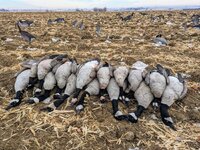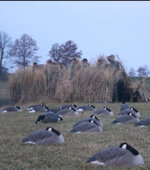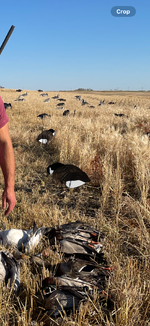Newbie waterfowl hunter. I got some good info on a basic starter pack for ducks this year—had a blast, enjoying the steep learning curve and exploring new places. We have a long canada goose season here. I’ve been a few times with friends, with a spread ranging from an overflowing truckload of full-body decoys, to nothing more than a dozen sillouettes. Most of my hunting would be on fields where they feed in the AM, or on sandbars or marsh edges where they come to loaf midday. There are both lessers and bigger birds, and as far as I can tell they seem pretty well mixed together. For you guys that hunt canadas, I’d love any insight you have on “must haves” for an ultra-basic kit.
-do you need full-body decoys at all? If so, when? (a couple floaters for loafing areas?)
-sillouettes, socks, or both—and why?
-minimum number? Portability is important. I see groups of birds of all sizes both feeding and flying around, so what is a good minimum place to start?
-does it matter bigger decoys vs lesser decoys?
On sillouettes, how much difference does flocking make?
On socks, I see them both with and without heads. How much difference does it make, and are there caveats (ie maybe “no heads needed if supplementing full body decoys, but you really need heads if they are the bulk of the spread”)
How necessary is a call? Suggestions for the most basic starter call? Aiming for minimum “non-throwaway” investment here.
Any other pieces of info or advice?
Thanks in advance!
-do you need full-body decoys at all? If so, when? (a couple floaters for loafing areas?)
-sillouettes, socks, or both—and why?
-minimum number? Portability is important. I see groups of birds of all sizes both feeding and flying around, so what is a good minimum place to start?
-does it matter bigger decoys vs lesser decoys?
On sillouettes, how much difference does flocking make?
On socks, I see them both with and without heads. How much difference does it make, and are there caveats (ie maybe “no heads needed if supplementing full body decoys, but you really need heads if they are the bulk of the spread”)
How necessary is a call? Suggestions for the most basic starter call? Aiming for minimum “non-throwaway” investment here.
Any other pieces of info or advice?
Thanks in advance!




